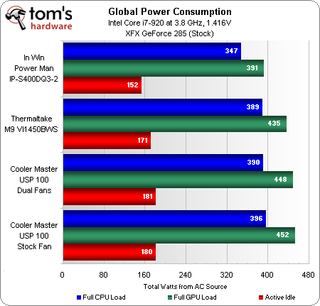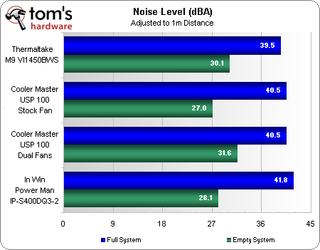Three Gaming Cases, With Power, Under $100
Case and power supply combos always look like a bargain, but bargain-basement parts have always seemed to chase experienced builders away. Today, we consider three budget-enthusiast models to determine if any of them can meet our basic gaming needs.
Measured Test Results
We checked the CPU, GPU, and chipset temperatures following at least 40 minutes at full load, using eight threads of Prime95 to generate maximum CPU temperature and one instance of FurMark at 1280x1024, 8x AA to reach full GPU temperature. Results are sorted by CPU temperature first.

In Win’s low temperatures are deceiving because the case would not close over our 120 mm tower cooler. That cooler was specifically chosen for the performance gaming market In Win hopes to win over with its Griffin chassis, hence the chart is labeled only for the power supply. The true cooling winner is Thermaltake’s M9, a statistic we attribute partly to the case’s dual fans.
Cooler Master’s USP 100 is doubly beset by its lack of exhaust fan and an intake fan that doesn’t flow well, itself doubly hindered by a sideways hard drive cage and a restrictive fan grille. A second fan of similar specification can be added within this comparison’s $100 limit, and doing this dropped our CPU temperature by 4° Celsius.

Global power consumption is a completely different matter. In Win’s Power Man units have always worked extremely well in our low-spec systems, but this is the first time we’ve tried to power anything as mighty as the GeForce GTX 285 with one. An 80 PLUS Bronze rating is testament to this unit’s efficiency.
On the other hand, the highest-rated power supply is also the only model that didn’t require a dual 4-pin to single PCIe power adapter simply to run our graphics card. Cooler Master’s eXtreme Power 550W costs over $50 on its own, trumps competitors on 12V current capacity, and converts the greatest amount of input energy into heat.

We again find an irrelevant number in In Win’s “full-system” noise output, since the case couldn’t be closed over our CPU cooler—or any cooler over 4.5” with its side fan installed. Thermaltake’s M9 does the best job of containing our CPU fan’s excessive noise, while the USP 100’s single fan allows the empty case to be quieter.
Stay on the Cutting Edge
Join the experts who read Tom's Hardware for the inside track on enthusiast PC tech news — and have for over 25 years. We'll send breaking news and in-depth reviews of CPUs, GPUs, AI, maker hardware and more straight to your inbox.
Current page: Measured Test Results
Prev Page Test Settings Next Page Energy And Acoustic Efficiency-
xc0mmiex In "Measured Test Results", first chart, temperature over ambient in degrees Celsius... even at freezing temperature of 0C, CPU would be at 67+ C.... and on a hot day of 30C your CPU would be approaching boiling... i think its a little too toasty so there gotta be a mistake in there somewhere; wrong unit or mathReply -
dirtmountain Good article, i really enjoy these articles about squeezing the biggest bang for the buck out of builds. We'd all like to be able to drop big $$$$ on our systems, but sometimes reality (or the wife) puts a pretty low limit on how much we can spend.Reply -
JonnyDough ReplyUnfortunately, Cooler Master does not include an exhaust fan.
I would not only prefer not to have one if not necessary due to noise, but I would also prefer to purchase one of my choosing so this is not necessarily a bad thing. -
falchard I think in cases more people are looking at aesthetics and ruggedness over temps and acoustics as nearly all cases have acceptable values. When it comes to this NZXT and Rosewill have really seperated themselves from other cases under $50.Reply -
JonnyDough I agree, but as an enthusiast I'm really loving that Cooler Master case. I tend to like front to back air flow just because it helps direct noise away from me and I can cool my hard drives first and my GPU last since that seems to be the order of coolest to hottest operating temps.Reply
I suspect with a bit higher power draw Cooler Master's PSU may perform a bit more admirably on efficiency. The only way to really know is to test the PSUs against each other and measure power draw of the PSUs themselves (until they power off preferably!) under load/idle. If you're going to make a statement about energy efficiency at all then it is my belief that you should test them. -
Crashman xc0mmiexIn "Measured Test Results", first chart, temperature over ambient in degrees Celsius... even at freezing temperature of 0C, CPU would be at 67+ C.... i think its a little too toasty so there gotta be a mistake in there somewhere; wrong unit or mathNo, it's an overclocked Core i7 at eight threads of Prime95, if you find those numbers shocking you're thinking of the wrong CPU.Reply
falchardI think in cases more people are looking at aesthetics and ruggedness over temps and acoustics as nearly all cases have acceptable values. When it comes to this NZXT and Rosewill have really seperated themselves from other cases under $50.These are basically $40 cases in this article. Two of the cases in the review are already far better than this one:
http://www.tomshardware.com/reviews/gaming-computer-case,2579-5.html
That is to say, two of these $40 cases are vastly superior to that $100 case. So you can say what you like, but words alone will not convince me. -
grossemesser Why in blazes you did NOT include in this... comparison the amazingly incredible HAF 922??? Its way better than any of these and costs only $90 Plenty of space, cable management space and of course AIRFLOW! it even has slots in the door so you can fit one big or two small fans... Anyways what can i say, you should have included itReply
... ummm sorry didn't get the WITH POWER part hehe... well i can just add that this is a great case and it is worth saving up the extra bucks for the added money you'll have to pay for the PSU
Most Popular


